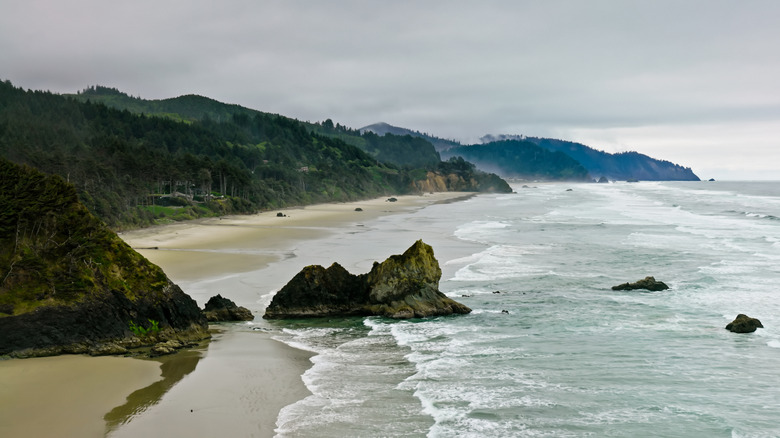The Deadly Reason To Avoid Turning Your Back On The Ocean While Visiting The West Coast
The West Coast of the United States is an incredible place to visit, with hundreds of miles of stunning coastline and spectacular hidden beaches for swimming, surfing, and simply strolling along the shore. But the ocean has many hidden dangers, including waves. One of the most dangerous types of waves you need to watch out for — even if you aren't going into the water — are sneaker waves. According to the National Weather Service (NWS), sneaker waves are strong waves that run up the beach farther than expected and can knock unsuspecting beachgoers off their feet and sweep them into the ocean.
Sneaker waves are not only dangerous– they can be deadly. Water temperatures plummet in winter, and the ocean can be cold year-round in Northern California and the Pacific Northwest. Frigid water can lead to hypothermia and drowning for those pulled into the ocean by a sneaker wave. These powerful waves can also dislodge logs and other debris along the shore, which can knock down or crush people, causing injury or even death. At least 26 people have died as a result of sneaker waves on the West Coast since 2010, according to a National Oceanic and Atmospheric Administration database.
The West Coast isn't the only place where you need to be on the lookout for these dangerous waves. Sneaker waves can and do occur on surf beaches around the world, and they're especially common on the iconic Reynisfjara Black Sand Beach in Iceland.
How to avoid sneaker waves
If you're planning a trip to the West Coast or any of the world's most dangerous swimming spots, there are several things you can do to avoid sneaker waves. It always pays to be informed when you travel, so make sure to look up the local tide, surf, and weather forecast of the area you're visiting. The NWS often issues a warning when there's an increased risk of sneaker waves, especially during swells and stormy weather. You should avoid swimming on any beach with a risk of sneaker waves. But even walking on the beach can be dangerous in these situations. The NWS advises staying farther up the beach than you think is necessary, and never turning your back on the ocean. Dry sand isn't an indicator that you're safe, as sneaker waves can surge more than 150 feet up a beach.
Even if there's no heightened risk of sneaker waves, it's best to check water conditions before you go in. The NWS suggests watching the ocean from higher ground for at least 20 minutes first and observing wave patterns. A sneaker wave is often preceded by 10 to 20 minutes of smaller waves. If you see someone get caught by a sneaker wave, do not go into the water after them. Instead, the best thing you can do is call 911 and keep an eye on their location in the water.

